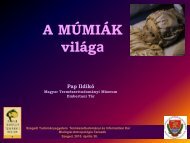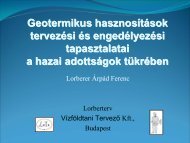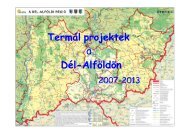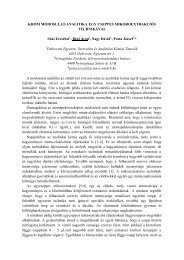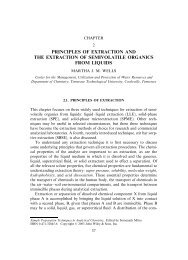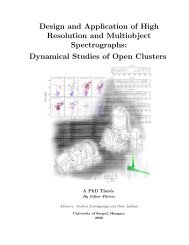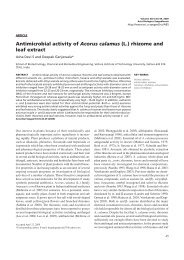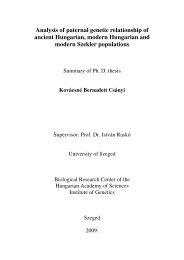Anthropological sketch of the prehistoric population of the ...
Anthropological sketch of the prehistoric population of the ...
Anthropological sketch of the prehistoric population of the ...
Create successful ePaper yourself
Turn your PDF publications into a flip-book with our unique Google optimized e-Paper software.
Z<strong>of</strong>fmann<br />
<strong>of</strong> <strong>the</strong> cca 120 series included in <strong>the</strong> analysis, which may<br />
ei<strong>the</strong>r be caused by <strong>the</strong> errors <strong>of</strong> <strong>the</strong> sample (uncertain dating,<br />
finds indicating strong brachycephalisation from <strong>the</strong> Vinca<br />
site), or points to a different origin <strong>of</strong> <strong>the</strong> Starcevo <strong>population</strong><br />
(<strong>the</strong> anthropological composition <strong>of</strong> <strong>the</strong> Neolithic <strong>population</strong><br />
within <strong>the</strong> Western and Central Balkan is absolutely unknown).<br />
The contacts <strong>of</strong> <strong>the</strong> Protonordic-Cro-Magnoid, later<br />
gradually gracilised ALP <strong>population</strong>s point outside <strong>the</strong><br />
eastern Carpathians, disregarding <strong>the</strong> above mentioned<br />
Penrose contacts to <strong>the</strong> K (S) C, referring to <strong>the</strong> direction <strong>of</strong><br />
<strong>the</strong> place <strong>of</strong> <strong>the</strong> formation <strong>of</strong> <strong>the</strong> <strong>population</strong>. In agreement<br />
with <strong>the</strong> archaeological data, <strong>the</strong> ALP <strong>population</strong> displayed<br />
no Penrose contacts with Central European or Bohemian and<br />
German <strong>population</strong>al groups <strong>of</strong> <strong>the</strong> Linear Pottery Culture,<br />
so <strong>the</strong>y must have had a different origin.<br />
There is no significant Penrose result between <strong>the</strong> series<br />
<strong>of</strong> <strong>the</strong> so-called Central European Linear Pottery <strong>population</strong><br />
and <strong>the</strong> Western Linear Pottery <strong>population</strong> (except for <strong>the</strong><br />
Bruchstedt series which is totally different from <strong>the</strong> former),<br />
<strong>the</strong>re seems to be an identity, however, with <strong>the</strong> contemporary<br />
Bohemian Linear Pottery series. The origin <strong>of</strong> <strong>the</strong>se two<br />
Central European <strong>population</strong>s <strong>of</strong> <strong>the</strong> Linear Pottery entity<br />
must have been, <strong>the</strong> only possible interpretation deduced<br />
from <strong>the</strong> Penrose data, a local predecessor unknown to us,<br />
since this is <strong>the</strong> only way we can explain <strong>the</strong>ir detachment<br />
from <strong>the</strong> <strong>population</strong>s <strong>of</strong> both <strong>the</strong> Alföld and <strong>the</strong> Western<br />
Linear Pottery cultures.<br />
Each <strong>of</strong> <strong>the</strong> <strong>population</strong>al groups <strong>of</strong> <strong>the</strong> later Neolithic<br />
cultures included in <strong>the</strong> analysis can be related to <strong>the</strong>se two<br />
Central European Linear Pottery <strong>population</strong>al groups. All <strong>the</strong><br />
three series representing <strong>the</strong> Sou<strong>the</strong>rn Transdanubian lengyel<br />
<strong>population</strong> (Aszód, Mórágy-B.1 and <strong>the</strong> combined south<br />
Transdanubian series, while <strong>the</strong> Lower Austrian Lengyel<br />
series demonstrating south-eastern contacts stands apart from<br />
this block), <strong>the</strong> Tisza culture in <strong>the</strong> Hungarian Plain and <strong>the</strong><br />
Sirmium <strong>population</strong>al group <strong>of</strong> <strong>the</strong> Vinca culture are connected<br />
with significant Penrose values and form, accordingly, an<br />
isolated, closed up block in <strong>the</strong> Carpathian Basin within <strong>the</strong><br />
Neolithic <strong>of</strong> Central and Eastern Europe, <strong>the</strong> <strong>population</strong> <strong>of</strong><br />
which did not mix with <strong>the</strong> neighbouring <strong>population</strong>al<br />
groups, at least it cannot be proved with Penrose values, but<br />
lived undisturbed in one place, seemingly without any<br />
significant outer influence, probably from before <strong>the</strong> Neolithic<br />
until <strong>the</strong> end <strong>of</strong> <strong>the</strong> Neolithic. Within <strong>the</strong> <strong>population</strong>al<br />
groups belonging to this autochtonous block, <strong>the</strong> robust and<br />
<strong>the</strong> gracile leptodolichomorphous varieties dominate, while<br />
<strong>the</strong> proportion <strong>of</strong> <strong>the</strong> Cro-Magnoid component is low.<br />
There are no Penrose data to prove <strong>the</strong> survival <strong>of</strong> <strong>the</strong><br />
autochtonous <strong>population</strong> in <strong>the</strong> Early Copper Age for lack <strong>of</strong><br />
series with sufficient item numbers. In <strong>the</strong> Tiszapolgár<br />
<strong>population</strong>, which is considered to be <strong>the</strong> direct follower <strong>of</strong><br />
<strong>the</strong> Neolithic Tisza culture according to archaeological finds,<br />
76<br />
a taxonomically demonstrable change occurred. The increase<br />
<strong>of</strong> <strong>the</strong> proportion <strong>of</strong> <strong>the</strong> Cro-Magnoid type suggests an outer<br />
influence. Although according to archaeological data <strong>the</strong><br />
invasion <strong>of</strong> <strong>the</strong> Pit Grave people <strong>of</strong> robust Cro-Magnoid type<br />
in <strong>the</strong> Carpathian Basin happened somewhat later, <strong>the</strong><br />
anthropological data certainly indicate an earlier infiltration<br />
during <strong>the</strong> Early Copper Age. The mixture <strong>of</strong> <strong>the</strong> Pit Grave<br />
and <strong>the</strong> local <strong>population</strong>s is proved again by taxonomic<br />
analyses, in contradiction to archaeological suppositions (<strong>the</strong><br />
occurrence <strong>of</strong> gracile Mediterranian type in Pit Grave<br />
burials).<br />
In <strong>the</strong> following period, <strong>the</strong> high proportion <strong>of</strong> <strong>the</strong> Cro-<br />
Magnoid type cannot be demonstrated any more in <strong>the</strong><br />
<strong>population</strong> <strong>of</strong> <strong>the</strong> Middle Copper Age Bodrogkeresztúr<br />
culture. The alien component, accordingly, had partly assimilated<br />
or disappeared from <strong>the</strong> region. The Penrose contacts<br />
<strong>of</strong> <strong>the</strong> series representing <strong>the</strong> Bodrogkeresztúr <strong>population</strong>al<br />
group also indicate that at least a part <strong>of</strong> <strong>the</strong> original autochtonous<br />
<strong>population</strong> survived in <strong>the</strong> region and took part in <strong>the</strong><br />
formation <strong>of</strong> <strong>the</strong> Middle Copper Age culture in <strong>the</strong> Hungarian<br />
Plain.<br />
According to <strong>the</strong> Penrose analysis, a new, alien <strong>population</strong><br />
arrived in <strong>the</strong> Carpathian Basin after <strong>the</strong> Middle Copper<br />
Age, which is in harmony with <strong>the</strong> archaeological data. The<br />
Late Copper Age <strong>population</strong>, <strong>the</strong> so-called Baden <strong>population</strong><br />
(its related cultures were <strong>the</strong> Kostolac in <strong>the</strong> South and <strong>the</strong><br />
Cot<strong>of</strong>eni in Transylvania) had strong sou<strong>the</strong>rn/south-eastern<br />
components according to <strong>the</strong> Penrose contacts, which is<br />
again in harmony with archaeological <strong>the</strong>ories. The animal<br />
breeding <strong>population</strong>al groups flooded <strong>the</strong> whole <strong>of</strong> <strong>the</strong><br />
Carpathian Basin, while <strong>the</strong> cultivating (archaeologically<br />
latent?) autochtonous <strong>population</strong>s seem to have survived <strong>the</strong><br />
invasion. Namely, <strong>the</strong> series from <strong>the</strong> cemeteries <strong>of</strong> <strong>the</strong> Maros<br />
-Perjámos <strong>population</strong> that developed in <strong>the</strong> early Bronze Age<br />
and flourished during <strong>the</strong> Middle Bronze Age in <strong>the</strong> sou<strong>the</strong>rn<br />
part <strong>of</strong> <strong>the</strong> Hungarian Plain testify with <strong>the</strong>ir Penrose data<br />
that, beside certain sou<strong>the</strong>rn/south-eastern components, both<br />
<strong>the</strong> Middle Copper Age Bodrogkeresztúr <strong>population</strong> marking<br />
<strong>the</strong> continuity <strong>of</strong> <strong>the</strong> autochtonous <strong>population</strong> and <strong>the</strong> Baden<br />
<strong>population</strong> immigrating during <strong>the</strong> Late Copper Age took<br />
part in <strong>the</strong> formation <strong>of</strong> <strong>the</strong> new Bronze Age culture. In a<br />
biological sense, accordingly, <strong>the</strong> survival <strong>of</strong> <strong>the</strong> autochtonous<br />
<strong>population</strong> <strong>of</strong> <strong>the</strong> Carpathian Basin probably going<br />
back to Mesolithic roots can be demonstrated even in <strong>the</strong><br />
Middle Bronze Age.<br />
Contrary to <strong>the</strong> continuity <strong>of</strong> autochtonous <strong>population</strong>s in<br />
<strong>the</strong> sou<strong>the</strong>rn part <strong>of</strong> <strong>the</strong> Hungarian Plain, new, alien <strong>population</strong>al<br />
groups appeared in <strong>the</strong> central and western parts <strong>of</strong> <strong>the</strong><br />
Carpathian Basin. The people <strong>of</strong> <strong>the</strong> so-called Bell-beaker<br />
culture occupied a large part <strong>of</strong> Europe, while in <strong>the</strong> Carpathian<br />
Basin <strong>the</strong>y lived within a limited territory for a short<br />
time and did not mix with <strong>the</strong> local <strong>population</strong>, according to<br />
archaeology. Although <strong>the</strong>re are very few evaluable anthropo-





